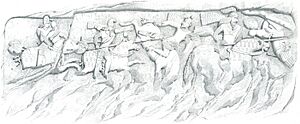Artabanus IV of Parthia facts for kids
Quick facts for kids Artabanus IV |
|
|---|---|
| King of Kings | |

The portrait of Artabanus IV on the observe of a Parthian drachm, Hamadan mint
|
|
| King of the Parthian Empire | |
| Reign | 213–224 |
| Predecessor | Vologases VI |
| Successor | Ardashir I (Sasanian Empire) |
| Died | 28 April 224 Hormozdgan (possibly Ram-Hormoz) |
| Issue | a daughter |
| Dynasty | Arsacid dynasty |
| Father | Vologases V |
| Religion | Zoroastrianism |
Artabanus IV, also known as Ardavan IV, was the last ruler of the Parthian Empire. He ruled from about 213 to 224 CE. He was the younger son of Vologases V, who passed away in 208 CE.
Contents
What's in a Name?
The name Artabanus comes from the Latin language. It is based on the Greek name Artábanos. This name itself comes from the Old Persian words meaning "the glory of Arta". In the Parthian and Middle Persian languages, his name was Ardawān.
His Time as King
Family Fights and Roman Wars
Around 208 CE, Vologases VI became king of the Parthian Empire after his father, Vologases V, died. For a few years, Vologases VI ruled without problems. But then, his brother Artabanus IV started a rebellion. This fight between the two brothers likely began around 213 CE.
Artabanus IV managed to take control of a large part of the empire. This included important areas like Media and Susa. Vologases VI probably only kept control of Seleucia, where he made his own coins.
The Roman emperor Caracalla tried to use this family conflict to his advantage. He looked for an excuse to invade the Parthian Empire. He asked Vologases VI to send him two people who had fled to Parthia. Surprisingly, Vologases VI sent them in 215 CE, which meant Caracalla lost his reason to invade. At this time, the Romans still thought Vologases VI was the main king.
Caracalla then decided to invade Armenia instead. This invasion did not go well for the Romans. After that, Caracalla again tried to start a war with the Parthians. He asked Artabanus IV to marry his daughter, but Artabanus said no. It's not clear if Caracalla was serious about the marriage.
By this time, Caracalla's choice to contact Artabanus IV showed that Artabanus was now seen as the stronger king. Vologases VI continued to rule a small area around Seleucia until about 221 or 222 CE. Artabanus IV soon fought Caracalla's forces and stopped them at Nisibis in 217 CE. Peace was made the next year. The Parthians kept most of Mesopotamia. However, Artabanus still had to deal with his brother Vologases, who kept trying to challenge him.
War with the Sasanians

Meanwhile, a new family called the Sasanians became very powerful in their home region of Pars. Their leader, Ardashir I, began to conquer nearby lands and even far-off places like Kirman. At first, Artabanus IV was not worried about Ardashir I's actions. But later, the Parthian king decided he had to fight him.
According to historical writings, Ardashir I and Artabanus IV agreed to meet for a battle in a place called Hormozdgan. Ardashir I arrived early to pick the best spot on the plain. He dug a ditch to protect his soldiers and took control of a water spring. Ardashir I's army had 10,000 horsemen. Some of them wore flexible chain armor, similar to Roman soldiers. Artabanus IV had more soldiers, but they were not as well prepared. They wore heavy, less comfortable armor.
Ardashir I's son, Shapur I, also fought in the battle. This is shown in old Sasanian rock reliefs (carvings). The battle happened on April 28, 224 CE. Artabanus IV was defeated and killed. This marked the end of the Arsacid (Parthian) era. It also began 427 years of Sasanian rule.
What Happened Next
After the battle, Ardashir I ordered the execution of Artabanus IV's chief secretary, Dad-windad. Ardashir I then took the grand title of shahanshah, which means "King of Kings". He began to conquer an area that would be called Iranshahr (Ērānshahr).
To celebrate his victory, Ardashir I had two rock carvings made in his royal city of Ardashir-Khwarrah (now Firuzabad). The first carving shows three scenes of fighting. One part shows a Persian noble capturing a Parthian soldier. Another shows Shapur I killing the Parthian minister Dad-windad with his spear. The third part shows Ardashir I throwing Artabanus IV off his horse.
The second carving likely shows what happened after the battle. It shows the victorious Ardashir I receiving the symbol of kingship. He gets it over a fire shrine from the Zoroastrian supreme god Ahura Mazda. Shapur I and two other princes watch from behind.
Ardashir I's forces soon drove Vologases VI out of Mesopotamia after 228 CE. The powerful Parthian noble families, known as the Seven Great Houses of Iran, still held power in Iran. But now, the Sasanians were their new rulers. The early Sasanian army was very similar to the Parthian army. In fact, most of the Sasanian cavalry were the same Parthian nobles who had once served Artabanus IV.
Memories of the Parthian Empire never completely disappeared. Later, in the late 500s CE, some Parthian leaders like Bahram Chobin and Vistahm tried to bring back the old empire. However, they were not successful.
Images for kids
See Also
 In Spanish: Artabano IV de Partia para niños
In Spanish: Artabano IV de Partia para niños



